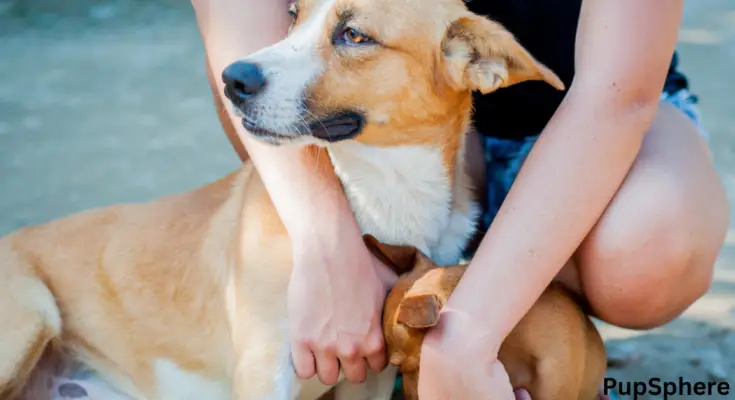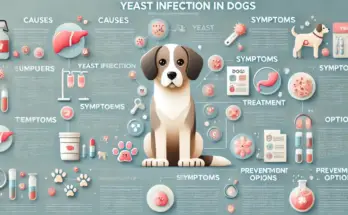Table of Contents
ToggleIntroduction
Panting is a natural way for dogs to cool down, just like sweating helps humans stay cool. But if your dog starts excessive panting at night without any clear reason, it could signal something unusual and might need attention.
7 Main Reasons Your Dog Is Panting and Restless
Dogs can’t sweat like humans to cool down; instead, they rely on panting. Panting helps them manage their body temperature by replacing warm air from their lungs with cooler air, triggering evaporative cooling. But if your dog is panting and restless, there might be an underlying issue. Here are the seven main reasons why this could be happening:
1. Respiratory Issues in Dogs
Respiratory illness in dogs can make it difficult for their body to get enough oxygen and eliminate waste like carbon dioxide. Conditions such as tracheal collapse and laryngeal paralysis are common, especially in senior dogs.
Tracheal collapse, often seen in small dog breeds, causes the windpipe to narrow, leading to increased coughing, especially when they’re excited. Laryngeal paralysis, or “lar par,” affects the nerves controlling the larynx, making it harder for large breeds to breathe. This condition can cause a unique “roaring” sound and prevents dogs from panting efficiently, which may result in dangerously high body temperatures after even mild activity.
2. Heart Disease in Dogs
Excessive panting in dogs can be a sign of heart disease. You might also notice your dog coughing or breathing heavily after a simple walk or light exercise.
The heart is crucial for delivering oxygen throughout the body. When it isn’t functioning properly, your dog’s body struggles to get the oxygen it needs for everyday activities. Conditions like valve disorders, arrhythmias, cardiomyopathies, and heartworm disease can all impact the heart’s ability to pump effectively.
Your vet can often spot heart murmurs or irregular heartbeats simply by listening to your dog’s chest, which is why regular check-ups are essential.

3. CCDS in Dogs
Canine Cognitive Dysfunction (CCD) refers to dementia-like symptoms that develop gradually in older dogs due to changes in the brain. These changes impact a dog’s behavior, motor skills, and memory, often leading to signs like excessive panting and restlessness.
CCD is most common in dogs over the age of 10. Unfortunately, dogs with CCD may become confused, experience a disrupted sleep-wake cycle, and even appear “lost” in their own home. Frequent pacing, especially at night, is a hallmark of CCD, and this condition is also known as “sundowner syndrome,” a term shared with similar symptoms in senior humans.
Other common signs of CCD include:
- Not responding when called (after ruling out deafness)
- Accidents in the house
- Restlessness and difficulty settling into sleep
- Disorientation or getting “stuck” in familiar spaces
- Changes in personality and behavior
While there is no cure for CCD, there are treatments available, including medications, supplements, and behavioral modification strategies.
4. Anxiety and Fear in Dogs
Just like humans, dogs can experience anxiety and fear. Triggers like loud noises or unfamiliar sights can lead to noticeable reactions. For instance, fireworks might cause a dog to tuck their tail, run for cover, or tremble, while others may stay close but show subtle signs, such as:
- Panting
- Pacing or restlessness
- Frequent yawning
- Avoiding eye contact
- Lip licking
Identifying the root cause of your dog’s anxiety is essential for effective treatment. Once the trigger is pinpointed, steps can be taken to reduce or eliminate it. In some cases, your veterinarian may recommend anti-anxiety medications or calming aids like pheromone diffusers, special diets, or treats.
If your dog has a noise phobia, like a fear of thunderstorms, heavy panting is often a sign of their stress and anxiety.

5. Anemia in Dogs
Anemia in dogs occurs when there aren’t enough red blood cells in a dog’s bloodstream. This can cause panting and restlessness, as the dog’s internal organs aren’t getting enough oxygen, and the brain demands more.
There are several causes of anemia in dogs, including blood loss from internal or external bleeding, illnesses like hemolytic anemia (where red blood cells rupture due to immune system attacks), and bone marrow diseases like genetic conditions or cancer that reduce red blood cell production.
Dogs with anemia often feel lethargic, may lose their appetite, and appear nauseous. If there’s internal bleeding, especially in the abdomen, the dog will also experience pain, which can lead to excessive panting.
To diagnose anemia, your vet will conduct routine blood work and may recommend additional tests like blood and urine tests, X-rays, and ultrasounds. Treatment depends on the underlying cause. For instance, antibiotics may treat anemia caused by infection, while medications like immunosuppressive drugs can address immune-mediated anemia. If the anemia is caused by injury or bleeding, emergency surgery may be required. In severe cases, a blood transfusion may be needed.
Pale gums often accompany an elevated respiratory rate due to anemia. It’s important to know your dog’s normal gum color by checking their mucous membranes regularly.
6. Pain in Dogs: Acute vs. Chronic
Arthritis, surgery, and injuries are common sources of pain in dogs. Some signs, like limping, are easy to notice, while others—such as panting, restlessness, or hiding—can be more subtle. For instance, a dog that suddenly starts limping after jumping may be experiencing acute pain. In contrast, dogs with arthritis or old injuries often deal with chronic pain that flares up over time.
It’s crucial to recognize signs of pain in your dog and consult a veterinarian for proper care. An elevated heart rate and panting can also indicate that your dog is in discomfort.
Important Reminder: Never give your dog human pain medications, as non-steroidal anti-inflammatory drugs (NSAIDs) for humans can be harmful to pets.
7. Cushing’s Disease Explained
Dogs rely on glands to release hormones like cortisol, which play a vital role in managing stress and regulating metabolism. However, when cortisol levels rise excessively, dogs—especially middle-aged and senior ones—can develop Cushing’s disease.
Common symptoms of Cushing’s disease in dogs include excessive panting, restlessness, increased thirst, appetite changes, and a distinctive pot-bellied appearance. This condition often results from tumors in the adrenal or pituitary glands or extended steroid use. Diagnosis usually involves blood tests like the ACTH stimulation test or LDDST.
Treatment depends on the underlying cause and may include surgery or medications like trilostane (Vetoryl). If your dog displays signs of Cushing’s disease, consult your veterinarian promptly to ensure proper care.
Panting and Restlessness? Consult Your Vet
Panting and restlessness in senior dogs are often more than just occasional behaviors—they may indicate underlying health issues that require attention.
If you’re unsure about the cause, consult your veterinarian. They can help identify and address the reasons behind these behaviors to ensure your dog’s well-being.
Urgent Warning: If your dog has difficulty breathing, gray or bluish gums or tongue, or a resting respiratory rate exceeding 60 breaths per minute, seek immediate veterinary care. A serious condition linked to these symptoms is gastric dilatation and volvulus (GDV), also known as bloat.






Wonderful blog! I found it while searching on Yahoo News. Do you have any tips on how to get listed in Yahoo News? I’ve been trying for a while but I never seem to get there! Thank you
Yahoo News generally features high-quality and newsworthy content. Here are some tips to improve your chances of being listed there:
1. Create High-Quality Content
– Focus on newsworthy topics that are relevant to your niche, like dog-related trends or health tips for pets.
– Use professional language and ensure your content is error-free and well-structured.
– Add unique angles or insights to make your content stand out.
2. Submit to News Aggregators
– Yahoo News often pulls stories from aggregators like PR Newswire and Associated Press. Consider submitting your articles to these platforms.
– Use press releases to promote your blog and link back to relevant posts.
3. Optimize for Search Engines
– Make your content SEO-friendly with proper keywords, meta descriptions, and tags.
– Use keywords that align with your niche and attract attention, such as “dog health trends” or “pet safety tips.”
4. Build Credibility
– Gain backlinks from reputable websites in your niche.
– Collaborate with influencers or experts to boost your authority.
5. Engage with Journalists
– Build relationships with journalists who write for Yahoo News or similar outlets.
– Pitch them with compelling stories related to your blog.
6. Consistency and Timing
– Regularly post fresh and timely content to stay relevant.
– Cover trending topics, as these are more likely to catch Yahoo News’ attention.
I really enjoy looking through on this website , it has wonderful articles.